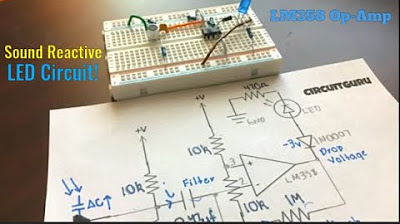Como Fazer um Sequencial de Leds (muito simples)
Summary
TLDRIn this video, Brendo guides viewers through the process of creating a sequential LED circuit for motorcycle turn signals. Using a 555 timer IC and a 4017 Decade Counter IC, he explains how the circuit works and how to build it on a breadboard. He covers key components like resistors, capacitors, and potentiometers, offering troubleshooting tips along the way. After assembling the circuit, he demonstrates how adjusting the potentiometer affects the LED speed. The project results in a functional, dynamic sequential LED effect, and Brendo invites viewers to follow along and improve the design for even better results.
Takeaways
- 😀 The video introduces a project where a sequential LED circuit is built to improve a motorcycle's turn signal functionality.
- 😀 The main components used in the circuit are the 555 timer IC and the 4017 decade counter IC.
- 😀 The 555 timer IC is used in astable mode to generate clock pulses, which drive the LEDs in a sequential pattern.
- 😀 The 4017 IC is responsible for receiving clock pulses from the 555 timer and alternates which LED is turned on based on the pulses.
- 😀 The circuit features a potentiometer that controls the frequency of the LED sequence, with lower resistance resulting in a faster sequence.
- 😀 The circuit includes key passive components like resistors (1.5kΩ), a capacitor (1μF), and a potentiometer (100kΩ).
- 😀 The LEDs are connected to the 4017 IC, and the sequential LED pattern is controlled by the IC's output pins (3, 2, 4, etc.).
- 😀 Proper attention to component orientation is important, such as the polarity of the capacitor and LED connections.
- 😀 The video provides a step-by-step guide on how to build the circuit on a breadboard, emphasizing the importance of following the diagram closely.
- 😀 Despite some initial wiring issues, such as incorrect grounding, the circuit was modified and successfully worked by adjusting the reset terminal of the 4017 IC.
Q & A
What is the purpose of the sequential LED circuit discussed in the video?
-The purpose of the sequential LED circuit is to create a LED sequence for motorcycle turn signals, where the LEDs light up in a running pattern rather than simply flashing on and off.
What are the two main components used in the circuit?
-The two main components used in the circuit are the 555 timer IC and the 4017 decade counter IC.
How does the 555 timer IC function in this circuit?
-The 555 timer IC functions as an astable multivibrator, oscillating between on and off states. It generates a clock pulse that controls the frequency of the LED sequence.
What role does the 4017 IC play in the circuit?
-The 4017 IC receives the clock pulses from the 555 timer and alternates between turning on different LEDs in the sequence. Each pulse activates a different output port on the 4017, lighting up a corresponding LED.
How does the potentiometer affect the circuit's behavior?
-The potentiometer controls the frequency of the oscillations. By adjusting its resistance, you can make the LED sequence run faster or slower.
What is the significance of the capacitor in the circuit?
-The capacitor is used to stabilize the circuit and ensure proper timing and signal processing between the components, specifically for the 555 timer IC.
Why is the polarity important when connecting the capacitor?
-The polarity is crucial because the capacitor has a specific positive and negative terminal. Connecting it incorrectly could cause the circuit to malfunction.
What issue did the creator face while testing the circuit?
-The creator initially encountered a problem where the LEDs did not behave as expected. After analyzing the circuit, they discovered that the reset pin (pin 15) of the 4017 IC needed to be properly connected, which fixed the issue.
What is the maximum voltage the circuit can handle?
-The circuit can operate with voltages ranging from 5V to 12V.
What is the next step in the project as per the video?
-The next step is to create a prototype of the sequential LED turn signal for the motorcycle, with potential modifications to improve the design further.
Outlines

This section is available to paid users only. Please upgrade to access this part.
Upgrade NowMindmap

This section is available to paid users only. Please upgrade to access this part.
Upgrade NowKeywords

This section is available to paid users only. Please upgrade to access this part.
Upgrade NowHighlights

This section is available to paid users only. Please upgrade to access this part.
Upgrade NowTranscripts

This section is available to paid users only. Please upgrade to access this part.
Upgrade NowBrowse More Related Video

How to Make an Automatic Emergency Light || Power Failure Backup Light

Rangkaian lampu dengan push button 1

Introduction to Sequential Circuits | Digital Electronics

Sound Reactive LED Circuit Using LM358 Op-Amp and Mic

Como HACER un SENSOR de OSCURIDAD con LDR + TRANSISTOR

Belajar dan Membuat Sensor Suara untuk menyalakan Peralatan Listrik di Rumah | Project Sederhana
5.0 / 5 (0 votes)